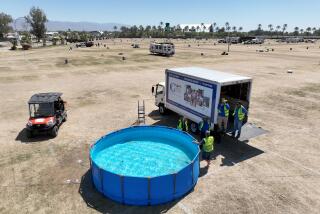Facility Allows City to Recycle Its Roadways : Environment: Thanks to L.A.’s Pacoima asphalt treatment plant, fewer highways end up down in the dumps.
Travelers on Ventura Boulevard may be surprised to learn that the roadway under their wheels may have once been Sepulveda Boulevard or Mulholland Drive.
That’s because of the city of Los Angeles’ little-known asphalt recycling plant in Pacoima--the largest and oldest of its kind in the nation.
The five-year-old facility has recycled nearly 1 million tons of asphalt taken from city streets, most of which would otherwise have ended up in landfills, city officials say.
In recognition of its recycling efforts, the city’s Bureau of Street Maintenance received an environmental achievement award recently from Renew America, a Washington, D.C.-based organization representing 28 environmental groups nationwide.
That’s not to say the facility is entirely environmentally friendly.
Since 1988, the plant--operated under contract with the city by Texas-based Cyclean Inc.--has been cited 10 times by the South Coast Air Quality Management District for emissions and permit violations, according to AQMD spokeswoman Paula Levy.
Cyclean has paid a total of $8,900 in fines to settle the violations, which included operating contrary to permit conditions, generating excessive visible emissions and creating a public nuisance by creating dust and odors, Levy said. The city of Los Angeles was also cited for creating too much dust at the plant and fined $500 in August, 1991, she said.
Levy described the violations as “not severe but somewhat chronic.”
Cyclean Manager Mohammad Shaikhsaheb defended the operation, saying many of the early violations occurred before Cyclean had modified the plant to reduce emissions. He said the later violations were probably due to dust and smoke generated by the trucks that haul the asphalt in and out of the facility.
Despite the violations, city officials lauded the plant as a breakthrough in asphalt recycling technology.
“This is a recycling process that works and it works in a big scale,” said Gregory Scott, a superintendent for the city’s Bureau of Street Maintenance.
Other municipalities and agencies, such as the California Department of Transportation, have recycled asphalt using different technologies. But Scott said Cyclean’s process allows the city to pave with 100% recycled asphalt while other processes allow only up to 60% recycled material to be used.
The key to Cyclean’s process is the plant’s six microwave heaters that work like regular microwave ovens to heat ground-up asphalt to regain its adhesive qualities, Scott said. A petroleum-based “rejuvenating oil” is added before the asphalt is reused, he said.
For the past decade or so, local municipalities have researched various asphalt recycling processes to find a way to reduce the amount of inert material such as asphalt and dirt that is dumped in area landfills.
About 9%, or 3.5 million tons, of the waste that has been dumped into landfills statewide is inert material, said Liza Smith, a spokeswoman for the California Integrated Waste Management Board. “Recycling asphalt is one of the things we promote,” Smith said.
Bob Doty, chief of Caltrans’ office of pavement in Sacramento, said Caltrans has been following Cyclean’s progress for years and plans to test its recycling process on a portion of the Santa Monica Freeway sometime next year.
“We are definitely interested in it . . . and we hope to construct one or two test sections in the next year or so,” he said.
Doty said the use of microwaves to heat the pavement is a unique advantage in the process. “Heating the mix without creating smoke is a unique feature of this plant and a very desirable feature,” he said.
Aside from environmental benefits of the operation, city officials say they have saved about $8 million that would have otherwise been spent buying virgin asphalt to repave streets.
Each year, the city repaves and repairs about 150 miles of deteriorating roadway with 800,000 tons of asphalt--more than any other municipality in the world, according to city officials.
Scott said the city decided to try the Cyclean process in 1987 to reduce the amount it was spending to dump asphalt into landfills.
Cyclean’s $10-million plant is located in a mostly industrial area next to the railroad tracks on San Fernando Road near the Simi Valley Freeway.
Every few minutes, diesel trucks roll in and out of the yard carrying tons of asphalt. The only permanent structures in the yard are two dilapidated buildings with peeling green paint that were used around the turn of the century as stables for mules.
Chunks of pavement are dumped from the trucks onto a pile nearly four stories high. Bulldozers move the pieces of pavement into a tall black machine that grinds the large chunks into gravel-size pieces. Later, another machine separates the large stones from the aggregate.
The ground-up asphalt paving is then put into a huge metal cylinder that spins like a clothes dryer and blasts hot air into the asphalt to remove moisture. From there, the asphalt is taken by conveyor belt past the six microwave transmitters which heat the asphalt to about 300 degrees. As the asphalt passes the microwave transmitters, several jets spray the clear liquid “rejuvenator” onto the black, steaming asphalt from above.
The final product is carried by conveyor belt to storage tanks or directly onto waiting trucks to be laid once again on city streets.
More to Read
Start your day right
Sign up for Essential California for news, features and recommendations from the L.A. Times and beyond in your inbox six days a week.
You may occasionally receive promotional content from the Los Angeles Times.







